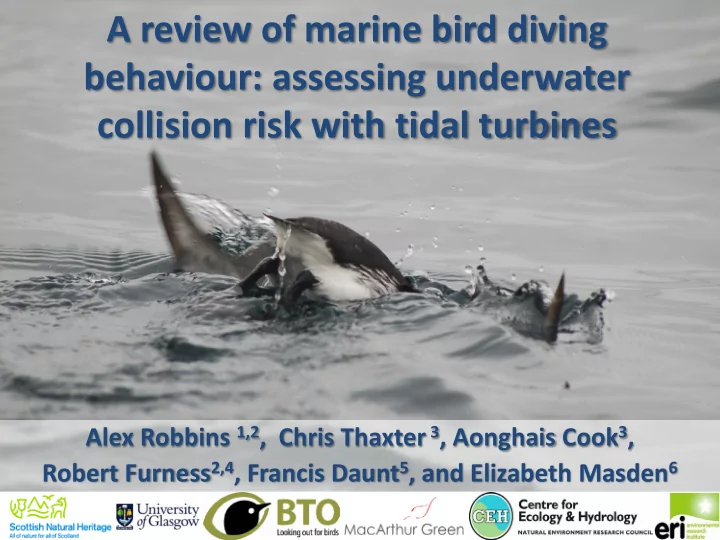

A review of marine bird diving Scottish Natural Heritage behaviour: assessing underwater collision risk with tidal turbines Alex Robbins 1,2 , Chris Thaxter 3 , Aonghais Cook 3 , Robert Furness 2,4 , Francis Daunt 5 , and Elizabeth Masden 6
Scottish Natural Heritage Outline 1. Background to the review 2. Literature review: The scope • Methods • 3. Results Data rich, moderate and poor species • 4. Conclusions and implications
Scottish Natural Heritage Assessing impacts on marine birds • Tidal turbines have the potential to impact diving birds through collision. • European legislation requires assessment of impacts: Environmental Impact Assessment (EIA) • Habitats Regulations Appraisal (HRA) • • Collision Risk Modelling has been developed for quantifying collision risk with windfarms… …. can we use the same approach underwater?
Scottish Natural Heritage Collision Risk Modelling Three main models are currently being used for birds: 1. Band collision risk model (CRM) 2. SRSL encounter rate model (ERM) 3. Exposure time modelling approach (developed by RPS under contract to SNH)
Scottish Natural Heritage Collision Risk Modelling Turbine parameters Probability Bird of Site usage encountering behaviour a turbine Bird biometrics
Scottish Natural Heritage CRM – tidal turbine designs…
Scottish Natural Heritage Bird foraging and diving behaviour Data are required on foraging and diving behaviour to calculate likely exposure to a tidal turbine: Proportion of dives at vulnerable depths • The accuracy of any model prediction is Dive depth, distribution of time spent at different depths, • proportion of benthic dives, ascent, descent and horizontal speeds dependent on the quality of input data! Proportion of time spent underwater/diving frequency • Dive duration, pause duration, dives/bout, bout duration • Alternative methods for estimating dive frequency • Dives/trip, trip duration, proportion of time at • foraging location, trips/day
Scottish Natural Heritage Literature review - scope We reviewed 18 diving parameters for 22 species of marine birds occurring in UK waters.
Scottish Natural Heritage Literature review - methods Values calculated for each parameter: • Maximum, mean maximum and global mean • We prioritised studies where direct methods have been • used to provide a measure of confidence for the data [1] . Confidence Measure Definition High >5 direct studies Moderate 2-5 direct studies Low Indirect measures or only 1 direct study Uncertain Survey-based estimates Poor Few survey estimates or speculative data [1] Thaxter, C.B., Lascelles, B., Sugar, K., Cook, A.S.C.P., Roos, S., Bolton, M., Langston, R.H.W., and Burton, N.H.K. 2012. Seabird foraging ranges as a preliminary tool for identifying candidate Marine Protected Areas. Biological Conservation 156: 53-61.
Scottish Natural Heritage European shag - data rich Global Locations Mean (Studies) Confidence Dive Depth (mean) 23.2m 3 (13) High Dive Duration 41.7s 5 (16) High Pause Duration 33.8s 3 (10) High Dives/Bout 20.9 1 (5) Moderate 1.5 ms -1 Ascent Speed 1 (4) High 1.8 ms -1 Descent Speed 1 (4) High Dives/Trip 26.6 1 (8) Moderate Forage Trip Duration 91.2 min 1 (5) Moderate Forage Trip Frequency 2.8/day 1 (7) Moderate
Scottish Natural Heritage Black guillemot - data moderate/ poor Global Locations Mean (Studies) Confidence Dive Depth (mean max) 26.5m 2 (2) Low Dive Duration 77.1s 3 (6) Moderate Shag – 41.7s Pause Duration 31.2s 1 (1) Poor Dives/Bout 8.75 2 (3) Low Shag – 20.9 Ascent Speed No data Descent Speed No data Dives/Trip No data Forage Trip Duration No data Forage Trip Frequency No data
Scottish Natural Heritage Red-throated diver – data poor Global Locations Mean (Studies) Confidence Dive Depth (mean) 5.3m 3 (3) Poor Shag – 23.2m Dive Duration 26.1s 2 (2) Poor Shag – 41.7s Black Guillemot – 77.1s Pause Duration 12.2s 1 (2) Poor Dives/Bout No data Ascent Speed No data Descent Speed No data Dives/Trip No data Shag – 91.2 min Forage Trip Duration 39.8 min 2 (2) Poor Shag – 2.8/day Forage Trip Frequency 10/day 1 (1) Poor
Scottish Natural Heritage Summary Current knowledge is variable across parameters and species: Presentation of parameters within studies is not always • comparable. Poorly studied parameters, such as horizontal speeds at • depth, are likely to be particularly relevant for tidal turbine collision risk. Some species are more difficult to study, however, • improvements in technology may increase the potential for future studies.
Scottish Natural Heritage Conclusions Some of the more vulnerable species are difficult to • study and confidence in these data is lower. There is a need to measure poorly understood • parameters, i.e. horizontal speed. Well studied species, such as shag, gannet and guillemot • will provide a useful opportunity for studying effects of renewables. The biggest unknown is how species will interact with • devices and if they will exhibit avoidance behaviours… … and will require robust post-construction monitoring to inform future assessments!
Scottish Natural Heritage Thank-you for listening This review is being undertaken collaboratively between:
Recommend
More recommend